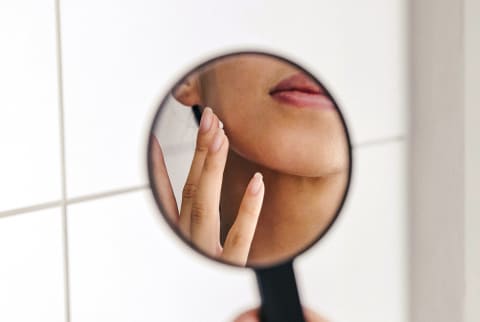
mbg Beauty Director
mbg Beauty Director
Alexandra Engler is the beauty director at mindbodygreen and host of the beauty podcast Clean Beauty School. Previously, she’s held beauty roles at Harper’s Bazaar, Marie Claire, SELF, and Cosmopolitan; her byline has appeared in Esquire, Sports Illustrated, and Allure.com.

Image by Julien Tell / Death to the Stock Photo
October 18, 2023
We carefully vet all products and services featured on mindbodygreen using our
Our selections are never influenced by the commissions earned from our links.
All dry skin boils down to a compromised skin barrier. This is true of chronically dehydrated skin, dryness from seasonal changes, or parched patches from changes to your skin care routine (ahem, using a harsh exfoliant). When the skin barrier function is weakened, the skin isn’t as able to trap and hold water. This results in a phenomenon called transepidermal water loss, where water from the dermis evaporates into the air around you.
To heal dry skin you must first strengthen the skin barrier. How, you might ask? Well, look for ingredients that exist in the moisture barrier to begin with, such as the below.
Fatty acids
Fatty acids are already present in the skin and are one of the most important parts of the stratum corneum. There are many kinds of fatty acids, from essential fatty acids (like Omega 3 and 6) to ceramides (which are intercellular lipids), and they all work together to create a robust moisture barrier that traps water in the dermis.
The good news is that you can get fatty acids from several sources, both plant and lab-derived. For example, shea butter is rich in stearic and oleic acid, and research has shown it’s been shown to seal moisture into the skin and protect the skin barrier.
Moringa seed oil is another great botanical oil. According to board-certified dermatologist Hadley King, M.D., moringa oil is made up of 40% monounsaturated fatty acids, with 70% of that being oleic acid. “This combination makes moringa oil great for supporting the skin barrier,” King says.
Some botanicals even improve your own lipid production. For example, oat oil not only helps reduce inflammation (something that damages the barrier), but it has been known to boost ceramide levels in the skin.
Humectants
Humectants pull water into the skin. You might hear “water-loving” or “hydrophilic” tossed around when discussing this ingredient category, and that’s because humectants actually bond to water—and this bond allows the ingredients to travel with water as it gets absorbed into the skin cells.
It’s important to clarify that humectants are a class of ingredients, which include hyaluronic acid, glycerin, panthenol (vitamin B5), lactic acid, aloe vera, and a few other noteworthy hydrators. The skin makes its own humectants, including hyaluronic acid. But it’s important to use them topically too (especially with age, as our supply declines as we get older).
Biotic ingredients
The skin microbiome, sometimes called the skin flora, is the term for the trillions of organisms that live on our skin. It’s also part of your skin barrier. When the skin microbiome is in dysbiosis, it leads to inflammation in the skin.
To keep skin balanced, look for pre- and postbiotics. Prebiotics—such as plant sugars, algae, and minerals—are ingredients that “feed’ good bacteria on the skin. Studies show that they can support skin barrier function—especially when paired with postbiotics.
The takeaway
To keep skin hydrated, you need to keep the skin barrier strong. It’s that simple. Look for lotions that utilize ingredients that support the skin barrier from multiple angles. Want some guidance? Here are some of our all-time favorite body lotions and face creams.

-v1646695196476.jpg?1148x800)